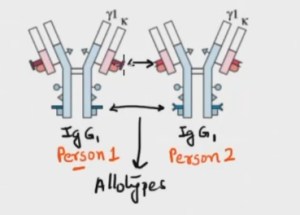Isotype, Allotype & Idiotype – What is the Difference?
Isotype, Allotype and Idiotype are antigenic determinants. We know that antigens that are proteins act as potent antigens and can induce the immune system. Similarly if you think about antibodies, they are glycoproteins so logically they also should be able to induce our immune system. Interesting, isn’t it? There are specific regions on antibodies which can induce the immune system. These regions on antibodies are called antigenic determinants.
These antigenic determinants fall under three categories: 1. Isotype, 2. Allotype and 3. Idiotype.
1. Isotype: Iso = Same
Definition: Isotype antigenic determinants characterize the classes and subclasses of heavy chain and types and subtypes of light chains.

For example, in humans there are 5 different types of antibodies; IgM, IgA, IgG, IgE and IgD based on the class of heavy chain they have (µ, α, γ, ε and δ respectively). That means we have specific set of genes which codes for these heavy chains. So there are specific sequences on constant regions of heavy and light chain (κ and λ) which decides what class or subclass of antibody it is.
It is called isotype (iso = same) because all members of a given species expresses all the isotypes in the serum.
For example, all immunologically normal individuals will have all five types of antibodies present in their serum i.e. IgM, IgA, IgG, IgE and IgD.
Therefore, different species inherits different constant regions genes and thus expresses different isotypes.
So if take antibodies from one species and inject it in another species it would result in anti-isotypic antibody production.
Location: Constant region of heavy chain and light chain.
Observed: In all the individuals of a species (immunologically normal individuals).
Importance: To measure Ig levels,
To check for immunodeficiency,
In detection of B cell tumors.
2. Allotype: Allo = Different
Definition: Allotype antigenic determinants are specified by the allelic forms of the Ig genes.

Although all the members of a species inherit the same set of Ig genes, there would be multiple alleles present for these genes which code for different amino acids. That means the amino acid sequence for the same antibody heavy chain would be slightly different in you than in me.
So if we take antibodies from one member of the species and inject it into another member of the same species it will result in production of antibodies against allotypic determinants.
Location: Constant region of heavy chain and light chain
Observed: During blood transfusion
During pregnancy
Importance: Monitoring bone marrow grafts
Paternity testing
Forensic
3. Idiotype: Idio = Own or Peculiar
Definition: Idiotypes are the unique antigenic determinants present on variable heavy chain and variable light region of individual antibody molecules.

When we encounter any Ag, the variable region of our Ab recognizes the Ag and our B cells produce specific antibodies (during affinity maturation by somatic hypermutaion) against that particular Ag. So when we encounter an Ag, our B cell makes very specific or peculiar Abs against it.
Let’s say for example, I encounter two different antigens i.e. Ag a and Ag b and produce IgG1 against both. In this case the idiotypic determinants for the IgG1 against Ag a will be different than IgG1 against Ag b.
Location: Variable region of heavy chain and light chain.
Observed: When we inject antibodies from a donor who is genetically identical to a recipient, it induces production of anti-idiotypic antibodies. In genetically identical twins the isotype and allotype will be the same but the idiotype will be different.
Importance: Treatment of B cell tumors
Vaccines
To understand more in details about how these determinants are important as mentioned, watch a video on this topic here
I hope this post helps 🙂

You must be logged in to post a comment.